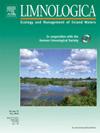水生大型无脊椎动物作为厄瓜多尔钦博拉索野生动物保护区湿地水质指标
IF 2
4区 环境科学与生态学
Q2 LIMNOLOGY
引用次数: 0
摘要
钦博拉索野生动物保护区(CR)位于厄瓜多尔中部,拥有16个湿地,分布在玻利瓦尔省(7)、通古拉瓦省(4)和钦博拉索省(5),海拔高度在3825米至4240米之间(海拔高度)。研究的目的是分析保护区湿地的生态质素。在每个湿地的三个点建立采样单元来测量水的物理化学变量,这有助于验证通过大型无脊椎动物获得的结果,因为如果这些生物决定了湿地的生态状态,则物理化学分析确定了污染的原因。大型无脊椎动物的采集方法主要有直接捕获法和索伯网法。计算了3个指标:哥伦比亚生物监测工作组(BMWP/Col)、蜉蝣目、翅翅目和毛翅目(EPT)和安第斯高原河流生态状况多指标(IMEERA)。共鉴定出7纲12目23科8664只,以透明藻科(Hyalellidae)最多。理化指标表明,湿地水适合农业灌溉和畜牧业使用,但不适合人类消费。同样,3种生物指数的结果表明,该水域应被列为受污染水域,因此这些生态系统提供的集水区也构成受污染的水生系统。因此,必须采取紧急和果断的措施来保护这些生态系统,因为这些生态系统是与它们共存的社区的主要供水来源。本文章由计算机程序翻译,如有差异,请以英文原文为准。
Aquatic macroinvertebrates as indicators of water quality in the wetlands of the Chimborazo Wildlife Reserve – Ecuador
The Chimborazo Wildlife Reserve (CR), located in central Ecuador, is home to 16 wetlands distributed in the provinces of Bolivar (7), Tungurahua (4) and Chimborazo (5), with altitudes ranging between 3 825 and 4 240 m above sea level (m.a.s.l.). The objective of the study was to analyse the ecological quality of the reserve's wetlands. Sampling units were established at three points per wetland to measure the physico-chemical variables of the water, which helped to validate the results obtained through macroinvertebrates, since if these organisms determine the ecological state of the wetlands, the physico-chemical analyses determine the reasons for pollution. Two methods were used to collect macroinvertebrates: direct capture and Surber net sampling. Three indices were calculated: Biological Monitoring Working Group for Colombia (BMWP/Col), Ephemeroptera, Plecoptera and Trichoptera (EPT), and Multimetric Index of Ecological Status for High Andean Rivers (IMEERA). A total of 8664 individuals belonging to 7 Classes, 12 Orders and 23 Families were identified, with the Family Hyalellidae being the most abundant. The physico-chemical variables indicated that the wetland water is suitable for agricultural irrigation and livestock use, but definitely not for human consumption. Similarly, the results of the 3 biological indices suggest that the waters should be classified as polluted and that therefore the catchment areas supplied by these ecosystems also constitute polluted aquatic systems. Hence the importance of adopting urgent and decisive measures for the conservation of these ecosystems, which constitute the main source of water supply for the communities that cohabit them.
求助全文
通过发布文献求助,成功后即可免费获取论文全文。
去求助
来源期刊

Limnologica
环境科学-湖沼学
CiteScore
3.70
自引率
5.90%
发文量
64
审稿时长
3 months
期刊介绍:
Limnologica is a primary journal for limnologists, aquatic ecologists, freshwater biologists, restoration ecologists and ecotoxicologists working with freshwater habitats.
 求助内容:
求助内容: 应助结果提醒方式:
应助结果提醒方式:


